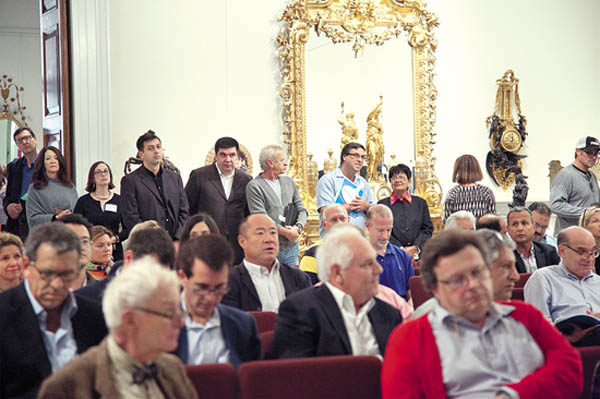The Vaux Hill Sale
The prices the items commanded at the sale were equally out of sight. The auction was held Sept. 25 at Freeman's, located at 1808 Chestnut St. in Philadelphia.
In a post-sale news release announcing results of the "white glove" event, one at which no lot went unsold, Freeman's said the 274 cataloged lots, most of which were continental furniture and decorative items, brought $3.9 million, more than three times the presale estimate. All told, the news release stated, 267 lots actually auctioned (after a few withdrawals and additions) drew nearly 400 potential buyers via the phones, online, and in the room. Because of the fierce bidding, it lasted twice as long as what otherwise would have been a 2-1/2-hour event.
Mrs. Safford, whose husband died several years ago, was selling the items and moving from Vaux Hill, where they had lived since 1991. Vaux Hill takes its name from James Vaux, a Philadelphia Quaker who built the first house there in 1776, when it was known as Fatland (some call it Fatlands). The current house at Fatland was built in 1843 and occupied in the mid-1900s by the legendary Pennsylvania state Democratic chairman Peter Camiel.
About half of the total lots went to just two bidders in the salesroom, one from Russia and one from East Asia. This included two of the top six items that brought six-figure prices: a gilt metal-mounted porcelain and giltwood secretaire cabinet with a presale estimate of $40,000 to $60,000 that went for $254,500 and a pair of rare Russian hand-painted and gilt decorated blue ground vases, expected to bring $4,000 to $6,000, that sold for $482,500 (all prices include buyers premium).
The secretaire cabinet, the auction's first lot, went to the most acquisitive of the buyers "in the chairs," as auctioneers like to call live bidders: a young man of Asian descent who refused to identify himself by name or nationality or to pose for a photo, but who spoke to his companion in Chinese.
It was the first of his more than 72 acquisitions, ending with a dozen lots of garden statuary that closed the sale. The same bidder also bought three lots that sold for double their presale estimates: a German porcelain-inset ebonized collector's cabinet with a presale estimate of $10,000 to $15,000 that sold for $42,500; a pair of Royal Vienna jeweled enamel cobalt ground covered vases on stands with a presale estimate of $20,000 to $30,000 that brought $80,500; and a Sevres-style porcelain cobalt vase depicting Napoleon's coronation. Based on Jacques-Louis David's painting of Napoleon's coronation as Emperor during which he snatched the crown from the Pope and crowned himself, it was expected to sell for $15,000 to $20,000. It went for $60,000.
The pair of hand-painted Russian vases that sold for $482,500 were among the 30 lots acquired by a Russian bidder. Also among them was a Sevres-style porcelain white-ground vase depicting a game of Blind Man's Buff with a presale estimate of $20,000 to $30,000. It sold for $158,500.
The buyers activity was not lost on Freeman's vice president and department head David Walker, who conducted the first three-quarters of the sale. "We were very pleased with the outcome of the auction," he said in the news release.
"It's interesting to see the shift in the marketplace. More and more, we're seeing interest from collectors in Asia and the Middle East for English and continental decorative arts."
To be sure, not everything was headed overseas. New York gallery owner Charles Cheriff made a half dozen purchases, including a late 19th-century gilt bronze mounted mahogany gilt vitrine with a presale estimate of $3,000 to $5,000, for which he paid $42,500.
The auction's top lot was a hand-painted Russian urn produced by Nicholas I's imperial porcelain factory in St. Petersburg. Estimated at $150,000 to $200,000 with bidding both in the room, on the phones, and the Internet, it was sold to a bidder in the chairs for $494,500, to the applause of others in the room.
Also of note was a German gilt-bronze mounted and hand-painted KPM porcelain tall case clock expected to sell for $80,000 to $120,000. It went to a bidder in the salesroom for $242,500.
Beneath the clock's face is a model of a seated girl and a large figure of Dawn blowing a trumpet. Below that is a scene of the gardens and palace at Sanssouci, Frederick the Great's one-time summer palace in Potsdam, Germany. It is believed to be one of only six of this model ever produced, including one given to Queen Victoria by her grandson Kaiser Wilhelm II in 1895 and placed in Osborne House on the Isle of Wight.
"The fact that every lot in this auction sold is a testament to the Saffords' ability to find the best examples of European decorative arts," said Freeman's chairman Samuel M. "Beau" Freeman II, who took over for Walker for the final 70 lots. "Yesterday was an exciting day for everyone involved."
One reason for the "white glove" achievement may have been the relative absence of minimum bids, or reserves. Both Walker and Freeman occasionally voiced a readiness to accept less than the minimum pre-sale estimate, particularly for some of the minor items toward the end of the auction.
Among the young Asian buyer's final acquisitions was a French patinated relief plaque depicting men in 17th-century costumes sword-fighting in the street. The presale estimate was $600 to $800, but Freeman let it go for $375. "It's here to be sold," he said.
For more, visit www.freemansauction.com.










